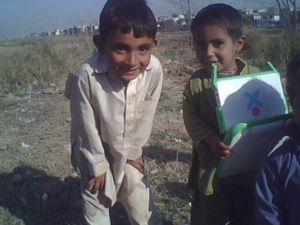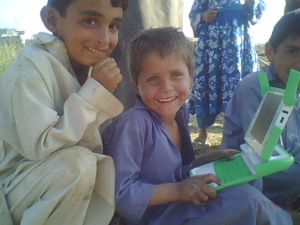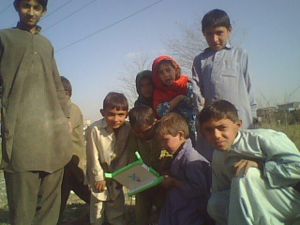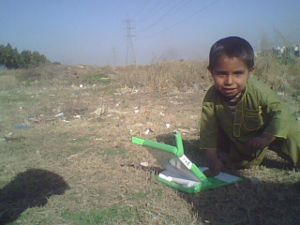OLPC Afghanistan: Difference between revisions
No edit summary |
No edit summary |
||
| Line 11: | Line 11: | ||
Flag=Flag of Afghanistan.svg| |
Flag=Flag of Afghanistan.svg| |
||
Wikipedia=Afghanistan| |
Wikipedia=Afghanistan| |
||
Support= |
Support=1| |
||
Deployment= |
Deployment=1| |
||
Keyboard=[[OLPC_Pashto_Keyboard|Pashto Layout]]| |
Keyboard=[[OLPC_Pashto_Keyboard|Pashto Layout]]| |
||
Spoken=Pashto (ps)| |
Spoken=Pashto (ps)| |
||
Revision as of 14:17, 16 October 2008
| Please copy/paste "{{Translationlist | xx | origlang=en | translated={{{translated}}}}}" (where xx is ISO 639 language code for your translation) to OLPC Afghanistan/translations | HowTo [ID# 175833] +/- |
Afghanistan
This is the wiki for the OLPC Afghanistan. The mission of this Not for Profit Organization is to create an environment for OLPC, take necessary steps to ensure every child in Afghanistan get the laptops and develop the Local Activities for OLPC laptops that could revolutionize how we educate our children. The goal is to provide every child in Afghanistan with new opportunities to explore, experiment, and express themselves in a collaborative way. Afghanistan is a very famous for being a multicultural country. Participation of the OLPC project in Afghanistan will not only revolutionize the way we teach children, the vision behind this "educational" project, but will also scale up the eco-system of sharing between the diverse set of communities existing in the central Asian countries.
Join the OLPC Afghanistan volunteer team.
Languages needed for localizationPlease let us know which language or languages are needed for localization for use by children in Afghanistan? Afghanistan has 34 provinces and 6 or 8 official languages and has more than 36 Languages in all. The language with the largest number of speakers is Pashto. Because of the large number of languages, Pashto and Dari have become the language of business and government. The other important languages and their respective provinces and regions and population numbers are as below:
IntroductionThere's a proverb in But our point is, what's wrong with that if it gets the job done? With OLPC Pilot approaching nearer, there are still a lot of strings to be translated (status). So lets get together, roll up our sleeves, get some snacks n drinks ready and have a Translation Nite-out! Translation HowToWe'll be using web based Pootle translation engine as our primary translation mechanism. But you are free to download PO files and translate it using GTranslator or using your own favourite text editor. Translation HowTo specific to the OLPC XO can be found here. Translation Guidelines for Pashto language can be found here. To download po file and translate it in your computer (faster way), follow these steps:
What should We translatePlease edit the following table to reserve the PO file you want to translate.
XO Core (100 % of 712 to be translated)Pashto Localization chart by Usman Mansour Ansari
XO Bundled (100% of 2971 to be translated)
Terminology (100% of 148 to be translated)
Packaging (100% of 145 to be translated)
Activation Server (100% of 1344 to be translated)
Scratch (100% of 517 to be translated)
XO Core (100 % of 712 to be translated)
XO Bundled (100% of 2971 to be translated)
Terminology (100% of 148 to be translated)
Packaging (100% of 145 to be translated)
Activation Server (100% of 1344 to be translated)
Scratch (100% of 517 to be translated)
E-Toys (100% of 25014 to be translated)
external links
This page is monitored by the OLPC team.
OLPC keyboard layoutsInstructions for setting up keyboard switching in Terminal are on the Customizing NAND images page. On bilingual XOs, the multiplication/division key is replaced with a keyboard switching key. Changing the language of the keyboard is independent of changing the language currently displayed. The language currently displayed can be changed by using the Language section of the Sugar Control Panel. Membrane keyboard layoutsEnglish (US international); Spanish (Latin America); Portuguese (Brazilian); Amharic (Ethiopic); Arabic; Nigerian (Igbo, Hausa, Yoruba); French; Thai; Urdu; Cyrillic (Russian); Turkish; Nepali; Mongolian; Kazakh; Devanagari; Uzbek; Pashto; Dari; Armenian; Khmer; Pulaar; Italian; Kreyòl; German; Chinese (Simplified); OLPC AZERTY Non-membrane keyboard layoutsStarting with the XO-1.5 HS ("High School") edition, the XO laptop has a traditional (non-membrane) keyboard available as an option: English (US International); Spanish (Latin America); Blank Keyboard ArtworkArtwork defining the inner dimensions of the membrane keyboard is available here: keyboard-blank.svg
| |||||||||||||||||||||||||||||||||||||||||||||||||||||||||||||||||||||||||||||||||||||||||||||||||||||||||||||||||||||||||||||||||||||||||||||||||||||||||||||||||||||||||||||||||||||||||||||||||||||||||||||||||||||||||||||||||||||||||||||||||||||||||||||||||||||||||||||||||||||||||||||||||||||||||||||||||||||||||||||||||||||||||||||||||||||||||||||||||||||||||||||||||||||||||||||||||||||||||||||||||||||||||||||||||||||||||||||||||||||||||||||||||||||||||



